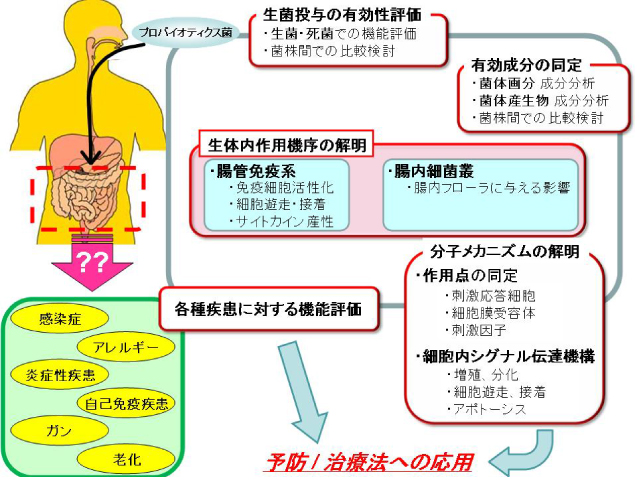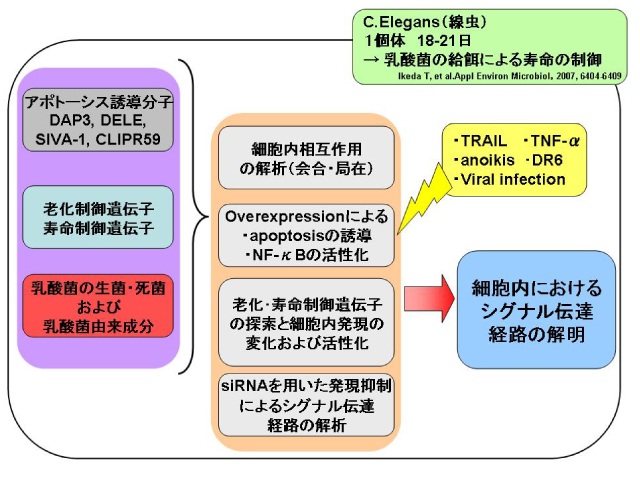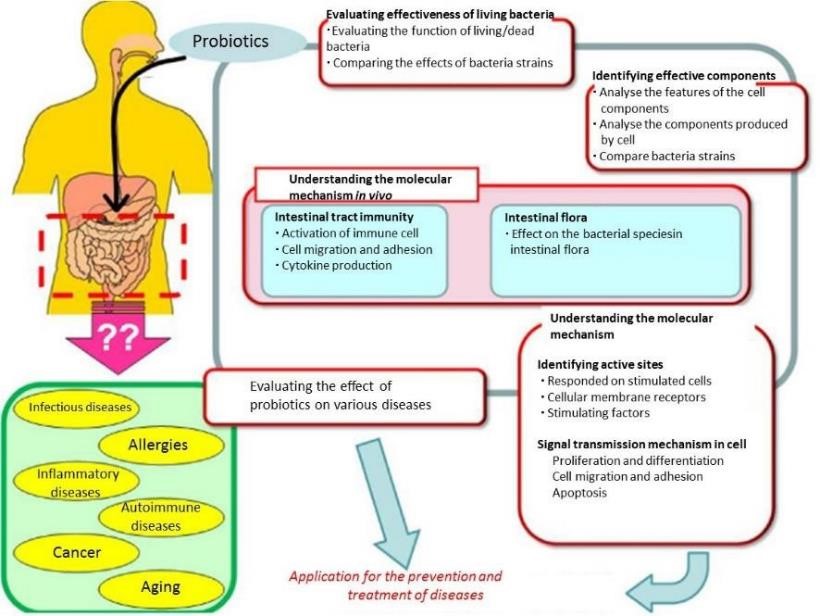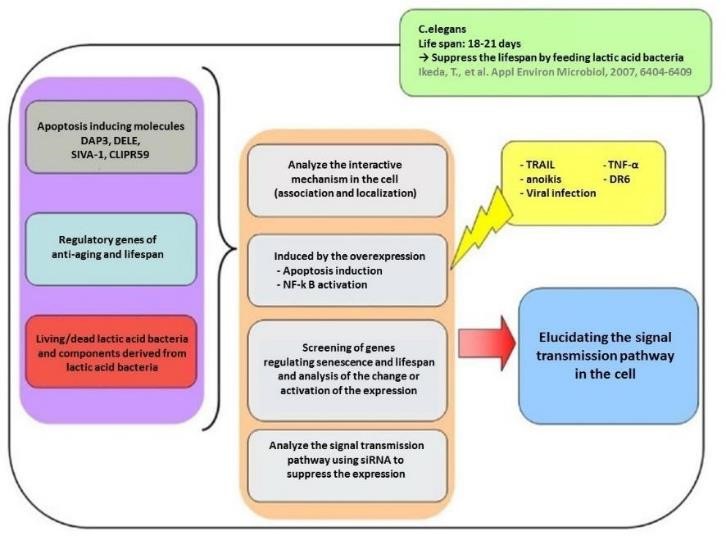現在の研究概要RESEARCH OBJECTIVES
 いろいろなプロバイオティクス菌株による感染症、癌、アレルギー、炎症性疾患の予防・治療効果をマウスの疾患モデルを用いて評価し、効果のある菌株を選択し、その生菌と死菌の効果の違いと機能を評価します。さらにその菌体画分あるいは産生物の成分分析をし物質を同定します。その物質による腸管免疫系の免疫細胞活性化や細胞遊走・接着およびサイトカイン産性能および腸内フローラへの影響を調べます。
いろいろなプロバイオティクス菌株による感染症、癌、アレルギー、炎症性疾患の予防・治療効果をマウスの疾患モデルを用いて評価し、効果のある菌株を選択し、その生菌と死菌の効果の違いと機能を評価します。さらにその菌体画分あるいは産生物の成分分析をし物質を同定します。その物質による腸管免疫系の免疫細胞活性化や細胞遊走・接着およびサイトカイン産性能および腸内フローラへの影響を調べます。
それらの効果や機能が認められた場合、応答する細胞やその物質の受容体、刺激因子を明らかにし、細胞増殖、アポトーシスや細胞遊走の誘導シグナル伝達経路を解析します。これまで私たちが解析してきたアポトーシス誘導分子や老化・寿命制御遺伝子の発現変化を調べ、それらの発現制御および細胞内会合や局在変化による機能調節機構を解明し、プロバイオティクスの疾病予防・治療への応用を目指します。
 これまでに乳酸菌は長寿、老化防止に効果的であるとの報告がされています。線虫C. elegans(Caenorhabditis elegans)では、通常の給餌である大腸菌を乳酸菌に代えることで、寿命が延長されることが示されていますが1)、その分子メカニズムの詳細については不明です。
これまでに乳酸菌は長寿、老化防止に効果的であるとの報告がされています。線虫C. elegans(Caenorhabditis elegans)では、通常の給餌である大腸菌を乳酸菌に代えることで、寿命が延長されることが示されていますが1)、その分子メカニズムの詳細については不明です。
C. elegansは、土壌に生息し細菌類を食べる体長約 1mm の線虫で、体は透明で顕微鏡下で観察が可能であり、細胞数が少ない(およそ1000個)こと、ライフサイクルが21日前後であることから、1960年代よりアポトーシス誘導機構、寿命・老化機構の解明のモデル動物として用いられています。C. elegansに対してRNAiを用いた実験手法により、原因遺伝子を同定することが出来るなど分子メカニズムの解析にも非常に有用です。
このことから、乳酸菌・乳酸菌生産物による寿命制御遺伝子への関わりを中心に、細胞の寿命に関係する生体内分子などとの関連性を解析し、生体の寿命を規定する分子メカニズムを解明します。
1) Ikeda T, et al.Appl Environ Microbiol,2007, 6404-6409
 We evaluate and observe how probiotics affect various diseases, including infectious diseases, cancer and allergies. We are also interested in probiotics for the prevention and treatment of inflammatory diseases. In conducting our research, hoose the most effective bacteria and, using mice as test subjects, we then compare the outcome and functions of two types of bacteria: living-bacteria and dead-bacteria. We observe the features of the probiotics and analyze/identify the components that are produced. We then investigate the influence of the probiotics on cytokine, intestinal flora and the immunity cell activation, proliferation, adhesion of intestinal immunity.
We evaluate and observe how probiotics affect various diseases, including infectious diseases, cancer and allergies. We are also interested in probiotics for the prevention and treatment of inflammatory diseases. In conducting our research, hoose the most effective bacteria and, using mice as test subjects, we then compare the outcome and functions of two types of bacteria: living-bacteria and dead-bacteria. We observe the features of the probiotics and analyze/identify the components that are produced. We then investigate the influence of the probiotics on cytokine, intestinal flora and the immunity cell activation, proliferation, adhesion of intestinal immunity.
Where a reaction is seen to have taken place, we try to identify the responding cell, the receptor of the substance, the stimulating factor and analyze the inducement signal transmitting route of the planocyte and apoptosis. We aim to use probiotics in disease prevention and treatment through our research into the apoptosis induction molecule, and the aging and lifespan control gene. We also examine the difference in appearance between them, working to reveal their appearance control, the functional adjustment mechanism of intracellular association and any altered localization.
 It has been reported that lactic-acid bacteria is effective not only for longevity but also for anti-aging. Our experiment with the nematode caenorhabditis elegans (“C. elegans”) showed that, when we fed them lactic-acid bacteria instead of their usual feed (Escherichia coli), the duration of their life was extended. Details of the molecular mechanism, however, are unknown.
It has been reported that lactic-acid bacteria is effective not only for longevity but also for anti-aging. Our experiment with the nematode caenorhabditis elegans (“C. elegans”) showed that, when we fed them lactic-acid bacteria instead of their usual feed (Escherichia coli), the duration of their life was extended. Details of the molecular mechanism, however, are unknown.
C. elegans is a species of Nematode, and its body length is approximately 1mm. It lives in soil, eats bacteria and has a transparent body which enables us to easily observe experiment results using a microscope. C. elegans have very few cells (approximately one thousand) and their lifespan is 21 days. C.elegans has therefore been considered an ideal test-subject for understanding longevity, the anti-aging mechanism and the apoptosis inducement signal since the 1960s. Using RNAi with C. elegans in experimentation is very useful for analysing the molecular mechanism and identifying the causative gene.
Our aim is to identify the molecular mechanism which determines the living-body lifespan, and to discover how lactic-acid bacteria and lactic-acid composite affect the life-duration of the cell and biomolecule: how this impacts upon the life-long control gene.
1) Ikeda T, et al.Appl Environ Microbiol,2007, 6404-6409

